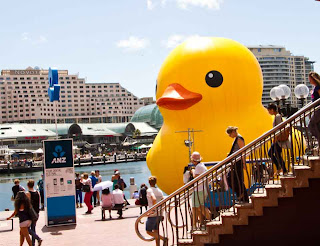Here we are ... back in Sydney again. First of all, a brief history lesson for you. This area was first discovered in 1642 (Abel
Tasman) and again in 1688 (William Dampier).
These discoverers found an Aboriginal people living in the Stone Age. It wasn’t until 1770 that Captain Cook sailed
into Sydney harbour and claimed the area for the British crown. The British government decided to use
Australia as a dumping ground to empty its overflowing prisons. In 1788, eleven ships arrived containing 776
prisoners who were dropped onto the barren rocks of Sydney harbour. From that date until 1868 when this practice
was abolished, a total of 162,000 convicts had been shipped from England and
Ireland to Australia. It was the hard
labour of these hardy souls that established this nation. Today, one quarter of
the population of Australia lives in the Sydney area.
 |
| Arriving at Sydney - 6 AM |
John got up at 6 AM to take photos as we sailed into
Sydney Harbour, under the bridge, and then docked in Darling Bay. We spent our
first day in Sydney walking about in the downtown, `Rocks`, area and taking a
tour of the Sydney Opera House. The
worst part of the tour was climbing the 250 stairs to get to the top. The other bad part was climbing back down
again. The Opera House is huge,
consisting of four distinct stages, and is absolutely amazing ... an
engineering marvel. Unfortunately we missed seeing La Boheme (last night before
we got here) and The Masked Ball which is tomorrow night after we leave. Oh well, next time! We did get to see a rehearsal for the
production “Blaze”, a “rap –dancing extravaganza that was not our “cup of tea”.
We also got the opportunity to watch the bridge climbers ... for only $250 you
can climb the bridge, but you are not allowed to take photographs while you are
up there (so, why bother?). There appear to be many people who enjoy the
challenge, never mind the cost.
 |
| Flat Stanleys at the Opera House |
 |
| Inside of the Opera Hpuse |
 |
| Roof detail showing the tiles |
 |
| Bridge Climbers |
 |
| A new career move for John |
On the second day, we got on a “Hop-on Hop-off”:
double-decker bus and spent four and a half hours touring Sydney and its
surroundings. We got to see much of the
new and old architecture of this very large city. Personally, the highlight of the tour
occurred when we switched buses and went on a two hour tour of the Bondi
(pronounced “bond-eye”) Junction and Beach area (wasn’t there a song many years
ago about “Bondi Junction”?). At the
beach, there was a strong wind and the waves were absolutely massive, so much
so that there were no surfers out. Gail
noticed that there were coloured warning flags posted on the beach; John mostly
noticed all the scantily, but artistically, clad beach lovers enjoying the sun.
While at Bondi Beach we also had a very nice seafood lunch overlooking the
waves. On the way back we got to see
some very expensive neighbourhoods (note: Ferrari’s parked in the driveway) as
well as some breathtaking views of the far-off Harbour Bridge and Opera House.
 |
| Bondi Beach |
 |
| Waves at Bondi Beach |
 |
| View of the city and bridge |
Finally, the bus dropped us off at the port near the ship, where there is the
world’s largest floating “rubber ducky”, about an hour before we left for
Brisbane, our next and last stop before we head home.
 |
| Goodbye Sydney ... until next time |

















